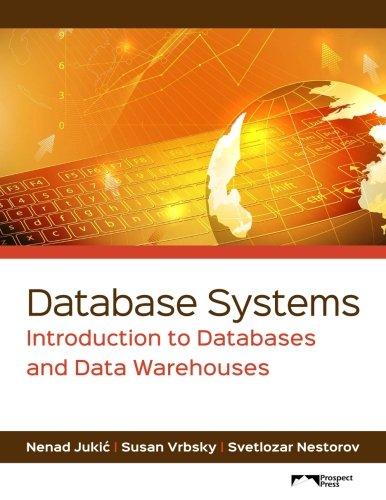Question
Part 1 Synopsis Level 0 Data flow Diagram T he requirements analysis phase answers the question, What does the user need and want from a
Part 1
Synopsis
- Level 0 Data flow Diagram
| T |
he requirements analysis phase answers the question, What does the user need and want from a new system? The requirements analysis phase is critical to the success of any new information system! In this milestone we need to identify what information systems requirements need to be defined from the system users perspectives.
The Data Flow Diagram (DFD) is a graphical representation of system which shows systems structure and components. The DFD shows how the data transforms in the system, what the source of the input is and what is the destination. Also, the DFD presents data structure and how its stored.
In this milestone you will explode the Context level DFD to Level 0 DFD to show sub-systems (processes). The Level 0 DFD shows internal data stores and how data flows through the processes.
- Child diagram definition
| C |
hild level diagrams show details and are built till needed level of details is reached. First, we show the information system as a single process on the Context diagram. Then, we decompose and show more details until all processes are functional primitives. Not all processes are exploded to the same number of levels- its not required to explode all processes to the same level. The main target is to reach the functional primitive which will be translated into units of program code.
Objectives
After completing this milestone, you should be able to:
- Create a Level 0 (System) Data Flow Diagram
- Create a Child Data Flow Diagram
Prerequisites
Before starting this milestone, the following topics should be covered:
Process Modeling - Chapter 9
Assignment
As a systems analyst or knowledgeable end-user, you must learn how to draw data flow diagrams to model business process requirements. The preliminary investigation and problem analysis phases of the methodology have been completed and you understand the current systems strengths, weaknesses, limitations, problems, opportunities, and constraints. You have already built the Context models (Milestone 3) to document business requirements for the new system. You now need to build the Level 0 (System) DFD and corresponding process models.
Activities
- Develop Level 0 DFD. Make assumptions where necessary.
- Draw one Child Diagram using the Level 0 diagram.
- Continue decomposition of one process up to primitive processes (Level 2, Level 3, etc.)
Part 2
Synopsis
Each process from primitive DFD may be developed as the individual module.
The software design technique which is based on the composing software from separate, interchangeable components is known as the module.
Modular design is a way to organize the complex system as a set of distinct components. Components may be developed, tested independently and then plugged together.
Modular design is supported by three types of logic:
- Sequential;
- Decision making or control;
- Iteration or repetition.
Sequential execution of steps one after another.
Decision making - execution of step depends on results of condition or set of conditions. Decision making is also called the selection or control.
Iteration execution of steps is repeated until the specific condition changes. Iteration is also called as repetition or looping.
In this milestone you will write the Structured English for primitive process.
Objectives
After completing this milestone, you should be able to:
- Write the Structured English for primitive process.
Prerequisites
Before starting this milestone the following topics should be covered:
- Child level DFD Chapter 9
- Physical level DFD Chapter 9 and12
- Structured English Chapter 9
- Fact-finding results Chapter 6
Assignment
The goal of this part of project is to write Structured English.
Activities
- Write the Structured English for one-two primitive processes. Include sequential, decision making and iteration logics. Your instructor will indicate what specific processes to document.
Step by Step Solution
There are 3 Steps involved in it
Step: 1

Get Instant Access to Expert-Tailored Solutions
See step-by-step solutions with expert insights and AI powered tools for academic success
Step: 2

Step: 3

Ace Your Homework with AI
Get the answers you need in no time with our AI-driven, step-by-step assistance
Get Started


